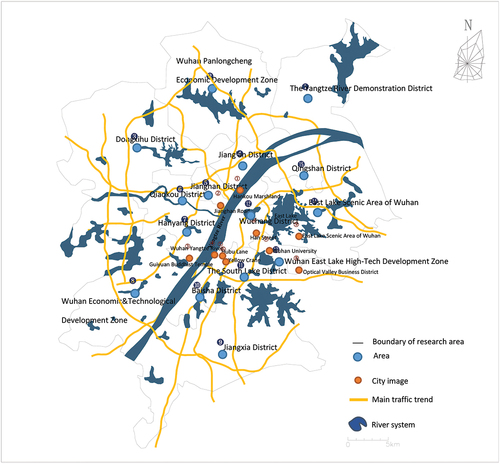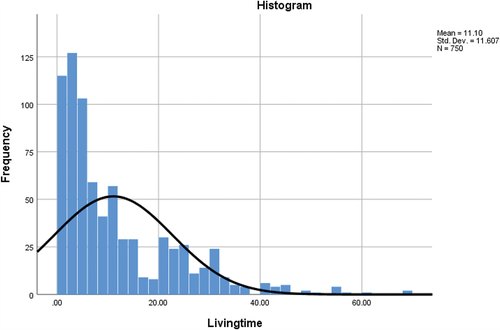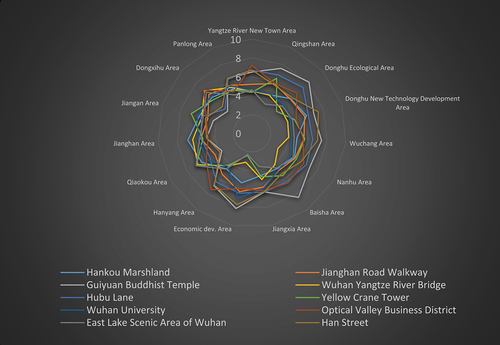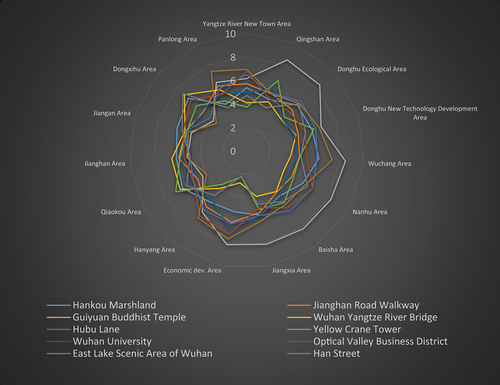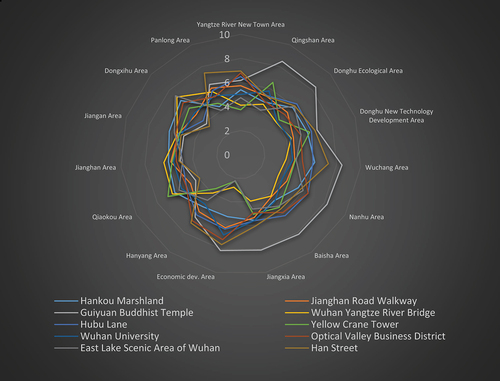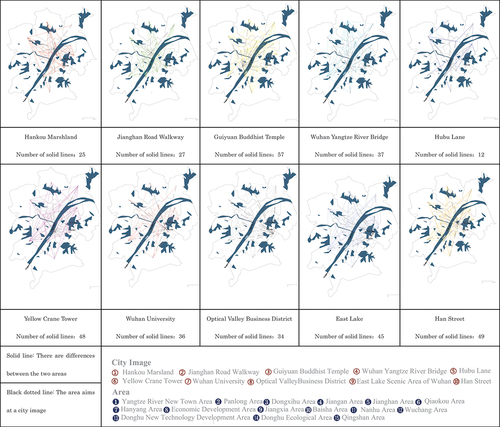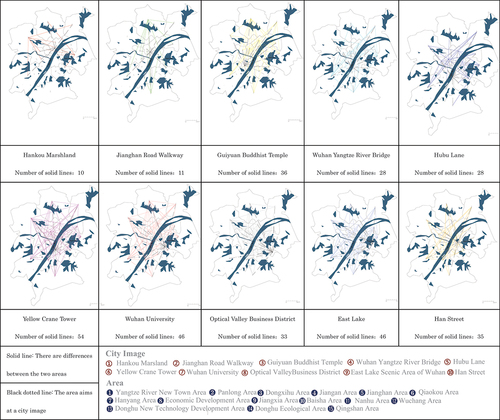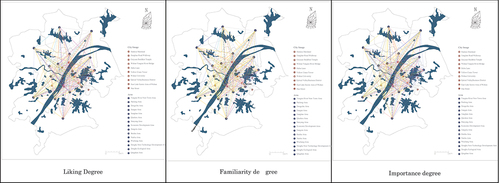ABSTRACT
With the rapid development of urbanization, Wuhan has gradually developed into a mega city, and the city image has also changed. The main purpose of this study is to explore the differences in different dimensions of respondents’ attitudes towards city image in different areas of Wuhan and analyze the relationship between respondents’ basic information and attitude evaluation. Explore the development status of mega city image to better understand the feelings of urban users and guide the development direction of mega city image in the future. We used the questionnaire method to collect the basic information of the respondents and the evaluation data of the city image in the three dimensions and used SPSS to carry out descriptive statistics, correlation analysis and ANOVA analysis on the data. Through analysis of the data, we can get that different basic information of the respondents leads to different attitudes towards city images. Basic information of respondents is significantly correlated with the attitude towards city images. The differences between the rational planned new town with industrial production as its function and other areas are the largest in liking degree and familiarity degree, but there is no significant difference in the attitude of importance degree.
1. Introduction
1.1. Research background
1.1.1. Mega city
The State Council issued The Notice on Adjusting the City Size Classification Standard in 2014, taking the urban permanent resident population as the statistical caliber, and cities with a permanent resident population of more than 10 million are recognized as mega cities.
1.1.2. Characteristics of Wuhan
Wuhan is a famous historical city with strong culture in China. By the end of 2020, the permanent resident population of Wuhan has reached 12.326 million (Wuhan Municipal Bureau of statistics, Citation2020), which has reached the population standard of mega city. The city of today is the product of building and planning on a scale never known before (Mohammed Abdullah Eben Saleh Citation2001).
Since the Qing Dynasty, Wuhan is divided into three towns, including Wuchang, Hankou and Hanyang. Since ancient times, Wuhan has been a multi-areal city. Wuhan is a city with rivers, lakes and ports, and its water area accounts for one fourth of the total area of the city, it is a city of great research significance (Shouni Tang et al. Citation2022). Before that, many scholars have studied the city images of Wuhan, but with the rapid development of Wuhan, great changes have taken place in the city images, so it is necessary to study the city images of Wuhan again.
1.1.3. City image
Spatial perception is the inner description or understanding of structure, entity and spatial relationship, in other words, the reconstruction and internal reflection of space and thought (Li Xiaoli et al. Citation2020). In daily space activities, urban residents will form a cognitive impression of the city through their perception of the external environment, combined with subjective experience and emotion. With the accumulation of time, some impressions gradually formed an orderly structure and formed a city image.
The concept of city image was first proposed by Kevin Lynch in 1960, and he wrote the book City Image. For the first time, he introduced environmental psychology into urban analysis and urban design and classified urban landscape into five elements (road, boundary, region, node and sign) (Kevin Lynch Citation1960). It is through these five elements that people build a comprehensive perception and impression of the city.
City image is the observer’s subjective impression of the city image. It is an important content of urban geography and planning research and has important guiding significance for shaping a unique urban space (Dan and Lixin Citation2022). The city image provides an important research perspective to explain the interaction between residents and urban environment in the city, and has important guiding significance for urban management and urban planning (Fengjun and Zhonglie Citation2014).
1.2. Research methods
In both strategic city planning and city marketing, a fundamental starting point is to evaluate the image of the city itself (Teodoro Luque-Martínez et al. Citation2007). According to the research method of Kevin Lynch, this study investigates the city images of Wuhan. Questionnaire-investigation was used to collect the basic information data of the respondents (gender, age, identity, length of residence in Wuhan, area) and their attitude towards the city images of Wuhan. Use SPSS to perform descriptive statistical analysis, correlation analysis and ANOVA analysis on the data to get the relationship between the city images and the basic information of the respondents.
1.3. Research purpose and significance
At present, the research on Wuhan’s city images is limited to Lin Yulian’s research 30 years ago. She investigated and analyzed the students in three towns of Wuhan at that time. Over the past 30 years, Wuhan has developed into a mega city with more areas and more detailed areal divisions. The sense of citizens in the central area is no longer limited to the intersection of three towns, the scope of sense of belonging has expanded, and citizens’ perception of Wuhan’s city image is also changing. Although there are many researches on city image, they are only single researches on a node or region, and the researches on city image of mega cities are insufficient. Therefore, the main purpose of this study is to fill the gap in the study of mega city image.
The main purpose of this study is to analyze the differences of respondents’ attitudes towards city image in different areas and the relationship between respondents’ basic information and attitude differences. Finding changes and problems in the image development process and providing direction for the future development of city image in Wuhan.
Through the study of Wuhan city image and basic information of citizens, it enriches the data of Wuhan city image research and innovates the theory of city image research. Imaginable cities are impressive, easy to identify, and can improve people’s quality of life, so they are of great significance to urban design (Liu Yifang Citation2005). Through this study, we can also better understand the citizens’ perception of the city image.It provides reference for the future development of Wuhan’s city image and urban design, enhance the citizens’ sense of belonging and place spirit, and create a happier and more recognizable city for the citizens.
1.4. Innovations
One of the main innovation of this study is to conduct in-depth and detailed research on the city image of larger cities in multiple dimensions. Wuhan is a city with hundreds of lakes. Many lakes of different sizes divide the city into many areas. Nature has divided the boundaries of various areas in the city, resulting in the development of Wuhan with strong geographical characteristics. With the continuous expansion of the scale of Wuhan, it has gone beyond the normal cognitive scope of people on the city, thus resulting in differences in urban cognition. Therefore, it brings differences in urban cognition.
From the perspective of general psychology, according to the emotional attitude, ability intensity and cognitive depth, the evaluation are divided into three dimensions: liking degree, familiarity degree and importance degree. The second innovation point is mainly conducts detailed analysis and research on the evaluation of city image by citizens in the above three dimensions.
2. Research status
2.1. Foreign research
Kevin Lynch was the first to put forward the word “city image”, and his book City Image opened a precedent of image theory research. Through years of careful observation and mass investigation, he analyzed Boston, Los Angeles and Jersey City, pointed out that image is the product of the interaction between subject and object. He proposed that city image can be divided into five elements: road, boundary, region, node and sign. He believed that citizens identify the features of the city through these five landscape factors. Since then, related research has emerged in an endless stream, and the theory has also been deepening. In recent years, many scholars still use Lynch’s method to study the city image of different cities. Fabio Cassia compared residents’ and tourists’ perception of city images in Verona by questionnaire-investigation. It is concluded that residents and tourists have similar cognition of city images in service and leisure, safety and entertainment. And the only significant difference of city images lies in municipal facilities. Specifically, residents are more critical of this dimension than tourists (Fabio Cassia et al. Citation2018). Tita Imamelina Mujihestia also used the method of questionnaire-investigation to explore the influence of city images on tourists’ revisit intention in Malang, Indonesia. The main data is obtained through a questionnaire-investigation of 180 tourists who visit Malang only for holiday reasons. He found that tourists’ perception of the city images plays an important role in promoting tourists’ revisit intention. Tourist satisfaction neutralizes the relationship between city images and tourists’ revisit intention (Tita Imamelina Mujihestia, Troena, and Hussein Citation2018). In recent years, Barbara Osóch used Kevin Lynch’s traditional research methods to study the city image of Poland’s Shicheqing. This study mainly discusses whether adolescents’ spatial perception is related to city image. Therefore, the subjects were matched according to gender and nationality, and adolescents aged between 12 and 17 were selected. They were asked to draw a map of the city of Shicheqing and a map of the central city, and to fill in an anonymous questionnaire. Statistics show that roads, regions and landmarks are the most common combination of elements to describe cities. Finally, they found that the younger the subjects were, the less detailed the cognitive map was, but it did not affect the spatial scope of the cognitive map (Osóch and Czaplińska Citation2019). Richard H. Rijnks focuses on what the images of the Veenkoloniën are within the Netherlands, and how the images change according to distance from the region. The data was obtained through a nationwide questionnaire (N = 922). The analysis shows that the valuations ascribed to the Veenkoloniën for living and recreation are lowest in the neighbouring regions, and increase with distance. In addition, the associations with the Veenkoloniën change from regional-specific to general-rural associations as distance increases (Richard H. Rijnks and Strijker Citation2013).
2.2. Local research
The local research on city image started late. Lin Yulian was the first to study the image of Wuhan city. Through means of questionnaire-investigation, she investigated the students from three schools in three towns of Wuhan. She analyzed the most beautiful, proud and recommended places in Wuhan, and got the residents’ evaluation on the environmental quality of Wuhan (Lin Yulian Citation1999). After that, Wang Yang and Wei Zhihao used the methods of questionnaire-investigation and cognitive map to study the city image space and its remodeling of Shijiazhuang. It mainly analyzes the spatial structure of city image in Shijiazhuang and studies the remodeling countermeasures. It is found that the city image space of Shijiazhuang residents is mainly affected by age, education level, occupation and location. Shijiazhuang needs to remodel the city images space from the aspects of urban culture and characteristic architecture (Yang and Zhihao Citation2013). Wang Shilong and Jin Mei studied the city images space of Mudanjiang by means of photo recognition and cognitive map. It is found that the commercial center represented by pedestrian street and the location of each building affect people’s spatial reflection of city images (Shilong and Mei Citation2020). Yang Qingqing investigated the city image of Hengyang, Hunan Province, by combining questionnaires and cognitive maps. It is worth noting that the recognition of Hengyang City is very high. The city image elements are mainly concentrated along the Xiangjiang River and around Jianshe Avenue. The citizens are not satisfied with the living environment of Hengyang City, but are satisfied with the places of leisure and entertainment. From the main urban area to the outer edge, there are four circles. Citizens in each district have “homogeneous satisfaction” with the city image (Yang Qingqing et al. Citation2015).
2.3. Summary
The imagery of a city constitutes the city’s external image, reflecting its the historical changes and core temperament (Yang and Wang Citation2021). There are extensive theoretical and practical studies on city image at home and abroad, but only for a specific place or region. At present, there is no research on the city image of mega cities in multiple dimensions. Thirty years ago, Lin Yulian’s research focused on Wuhan at that time. Now, Wuhan has developed into a mega city. No scholar has studied the city image of Wuhan after development for 30 years. Therefore, this study fills the gap this research filled the blank of this part of city image research.
3. Research process
3.1. Research area
Based on the distribution of population density in Wuhan and the areal subjective consciousness of citizens, this study takes the purchase restriction area of Wuhan as research range. Specifically including: 1. The Yangtze River Demonstration District; 2. Wuhan Panlongcheng Economic Development Zone; 3. Dongxihu District; 4. Jiang’an District; 5. Jianghan District; 6. Qiaokou District; 7. Hanyang District; 8. Wuhan Economic&Technological Development Zone; 9. Jiangxia District; 10. Baisha District; 11. The South Lake District; 12. Wuchang District; 13. Wuhan East Lake High-Tech Development Zone; 14. East Lake Scenic Area of Wuhan; 15. Qingshan District.
3.2. Investigation process
3.2.1. Pre-investigation
According to the theory of city image proposed by Kevin Lynch, the data were collected by questionnaire. In order to make the questionnaire more scientific and accurate, a pre-investigation was conducted before the formal investigation. 30 people in the densely populated transportation hub or business center in each area were randomly asked a question, and a total of 450 people were investigated in 15 areas. Respondents need to answer the question “when it comes to the city image of Wuhan, where can you think of?” by face to face. According to the statistics of all the images mentioned by the respondents, the top 10 were selected and ranked as follows: Optical Valley Business District, East Lake, Yellow Crane Tower, Wuhan Yangtze River Bridge, Wuhan University, Hankou Marshland, Jianghan Road Walkway, Hubu lane, Guiyuan Buddhist Temple, Han Street ().
Table 1. Characteristics of city image.
3.2.2. Questionnaire design
According to the results of the pre-investigation and previous studies, the types of formal questionnaires include single choice questions, open-ended blank filling questions and chart questions. The questionnaire is divided into four parts. First, fill in your basic information, including the length of residence in Wuhan (how many years), gender (male and female), age (below 20 years old/20–40 years old/40–60 years old/60 years old and above), identity (local-residents/non-local workers/non-local students/travel personnel). Then, the 10 images selected from the pre-investigation were ranked from three dimensions: liking degree, familiarity degree and importance degree (1 is the highest in the ranking).
3.2.3. Formal investigation
The members of the research team distributed 50 formal questionnaires in each area, and a total of 750 questionnaires were distributed and collected in 15 areas. The respondents are mainly pedestrians and shopping malls around the transportation hub in Wuhan. The questionnaire is filled in one-to-one way to ensure the effectiveness of each questionnaire. After the formal investigation, the final investigation area and the location map of 10 city images were obtained (). The blue dots represent the place where the questionnaire was distributed, the red dots represent the position of the 10 images.
4. Data analysis
The basic information data and attitude data of the respondents in all questionnaires were analyzed by SPSS to obtain the correlation between them.
4.1. Basic information statistics of respondents
Statistics were made on the number of respondents’ gender, identity, age and the length of residence in Wuhan, and the proportion of each factor in the total number of respondents was calculated ().
Table 2. Basic information of respondents (n = 750).
4.2. Correlation analysis
The respondents rank 1–10 in the degree of liking, familiarity and importance of the 10 city images. (1 means the highest attitude level, 10 means the lowest attitude level.) In order to find out the correlation between the data of gender, identity, age, the length of residence in Wuhan and the attitude data of 10 city images, this study makes a correlation analysis.
4.2.1. Correlation analysis of gender
The male and female were assigned 1 and 2 respectively. Correlation analysis was made between gender data and attitude data. The positive correlation coefficient shows that men have a higher evaluation level of the image, the negative correlation coefficient shows that women have a higher evaluation level of the image ().
Table 3. Correlation coefficient between the date of evaluation and respondents’ gender (n = 750).
From the , it can be seen that the liking and familiarity degree of respondents with Yellow Crane Tower is positively related to gender, and the importance degree of Guiyuan Buddhist Temple is also positively related to gender. The data show that men prefer and are more familiar with the Yellow Crane Tower, and they responded Guiyuan Buddhist Temple is very important. The importance degree of Hankou Marshland and the familiarity degree of Han Street are negatively correlated with gender. The results show that women are more familiar with Han Street and responded Hankou Marshland is more important.
From the above correlation analysis, it can be seen that men prefer and are more familiar with the images such as Yellow Crane Tower and Guiyuan Buddhist Temple, which carry the history, culture and religious belief of Wuhan. They also responded that these images are more important than others. The images of women’s high attitude level are Han Street, Hankou Marshland and other new shopping and entertainment places. Han Street are newly built commercial pedestrian streets with good shopping environment along with the development of Wuhan. It is the indispensable and emerging “WangHong” (online influencer) place in Wuhan. Hankou Marshland has beautiful natural environment and rich landscape. There are many historical buildings opposite the marshland, which are rich in heritage and gorgeous in style, attracting many young women to take photos here. The square in the marshland and the open space in the forest also provide the citizens with natural fitness places. These scenes all reflect the enthusiasm and openness of the people of Wuhan. And they are integrated with the beautiful scenery of the Marshland, which together constitute a unique image of Wuhan.
4.2.2. Correlation analysis of identity
The average values of the attitudes of local-residents, non-local workers, non-local students and travel personnel to the 10 images were calculated respectively. It can be seen from the and that the respondents with different identities have different attitudes towards city images in terms of liking degree, familiarity degree and importance degree (, ).
Figure 2. Radar chart of the average value of evaluation from respondents with different identities (n = 750).
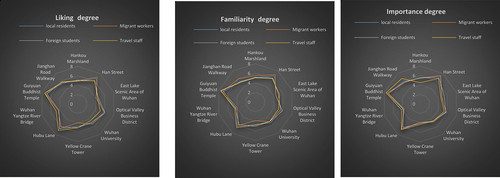
Table 4. Average value of different identities respondents’ attitude towards city image (n = 750).
The local-residents have a good attitude towards the East Lake, the Yangtze River Bridge and the Yellow Crane Tower. Non-local workers had the best attitude towards the Yangtze River Bridge and the Yellow Crane Tower. Non-local students have a good attitude towards the Yangtze River Bridge, Wuhan University, East Lake and Yellow Crane Tower. Travel personnel have a good attitude towards Jianghan Road Walkway, Hankou Marshland and Yangtze River Bridge. The Yangtze River Bridge and the Yellow Crane Tower have become the unique city cards of Wuhan.
The assignment of four identities is 1 for local-residents, 2 for non-local workers, 3 for non-local students and 4 for travel personnel. The assignment is based on the degree of participation in urban work and urban life. The positive correlation coefficient indicates that local-residents and non-local workers prefer and are more familiar with this image, and they responded that the image is more important. If the correlation coefficient is negative, it means that non-local students or travel personnel prefer and are more familiar with this image, and they also responded that the image is more important ().
Table 5. Correlation coefficient between the data of evaluation and respondents’ identity (n = 750).
It can be seen from the results of the correlation analysis in the that the degree of liking and familiarity with Guiyuan Buddhist Temple, the familiarity degree with Yellow Crane Tower, the familiarity and importance degree of East Lake are significantly positively correlated with identity. It means that local-residents and non-local workers prefer Guiyuan Buddhist Temple and are more familiar with Guiyuan Buddhist Temple, Yellow Crane Tower and East Lake. They responded that the East Lake is more important. The liking degree of Hubu lane and the three degree of Han Street are significantly negatively correlated with identity, which means that non-local students and travel personnel prefer Hubu lane. For them, the liking degree, familiarity degree and importance degree of Han Street are all very high.
Local-residents and non-local workers have a high evaluation of the images that carry history and culture, such as Guiyuan Buddhist Temple, Yellow Crane Tower and East Lake. Guiyuan Buddhist Temple is one of the four major Buddhist temples in Wuhan. The temple is full of incense and many people in Wuhan come here to burn incense and pray. Yellow Crane Tower known as one of the three famous buildings in the south of the Yangtze River, it is a landmark building inWuhan. East Lake is one of the first batch of national key scenic spots, attracting countless people to walk and enjoy the scenery. Non-local students and travel personnel have high evaluation on leisure and entertainment places, such as Hubu lane and Han Street. Wuhan is one of the cities with the largest number of college students in China. Hubu lane is a hundred-year-old lane in Wuhan, which is known as the first lane of Chinese snacks. Thousands of Wuhan special snacks are deeply loved by people. Han Street is a new place of shopping and entertainment, which attracts many students and travelers.
4.2.3. Correlation analysis of age
The age in the questionnaire was divided into four groups: 1 for those under 20 years old, 2 for those between 20 and 40 years old, 3 for those between 40 and 60 years old, and 4 for those over 60 years old. Correlation analysis was conducted with attitude data. The correlation coefficient is positive, indicating that the younger they are, the higher the level of their attitude towards the city images is. The correlation coefficient is negative, which indicates that the older they are, the higher their attitude to the city images is ().
Table 6. Correlation coefficient between the data of evaluation and respondents’ age (n = 750).
As can be seen from the above , the correlation coefficients of Guiyuan Buddhist Temple and Wuhan University are −0.074. The respondents’ liking degree for Guiyuan Buddhist Temple and Wuhan University is negatively correlated with their age, which means that the older they are, the more they like Guiyuan temple and Wuhan University. However, the liking degree, familiarity degree and importance degree of Han Street are positively correlated with age data, which means that older people have a lower ranking in liking degree, familiarity degree and importance degree of Han Street. Young people prefer and are more familiar with Han Street, they also responded that Han Street is very important.
From the above correlation analysis results, we can see that older people have higher attitude towards Guiyuan Buddhist Temple and Wuhan University than younger people. Most of the images with high attitude level of the elderly carry the history and culture of Wuhan. The young people have a high attitude towards new shopping and entertainment places such as Han Street.
The ancient trees in Guiyuan Buddhist Temple are towering. The flowers and trees are luxuriant. Guiyuan Buddhist Temple is also the seat of Wuhan religious association. Guiyuan Buddhist temple is filled with incense and there are many monks. Every festival, many old people come here to pray.
Wuhan University is surrounded by the East Lake and Luojia Hills. With beautiful campus environment and picturesque scenery, it is known as the most beautiful university in China. The palace style buildings in the school are simple and elegant, and 26 early buildings are listed as national key cultural relics protection units. Wuhan University has been established for 120 years, representing the belief and strength of the people. It is an irreplaceable institution of higher education in Wuhan.
Han Street is a world-class cultural tourism project with tourism, business and residential functions. It is a new large-scale shopping and entertainment place with good shopping environment. It was opened on 10 September 2011 and has attracted more than 2 million customers, most of whom were young people. Although Han Street does not carry the history and culture of Wuhan, it is also an indispensable and important city image of Wuhan.
4.2.4. Correlation analysis of the length of residence in Wuhan
The average living time of the respondents in Wuhan is 11–12 years, the shortest is 1 year (less than 1 year is calculated as 1 year), the longest is 68 years (, ).
Table 7. Statistics of respondents’ length of residence in Wuhan.
Correlative analysis of the two groups of data was conducted. The positive correlation coefficient shows that those who have lived in Wuhan for a short time prefer and are more familiar with the city images, they also responded that the image is more important. The correlation coefficient is negative, it means that those who have lived in Wuhan for a long time prefer and are more familiar with the city images, and they also responded that the image is more important ().
Table 8. Correlation coefficient between the data of evaluation and the length of residence in Wuhan (n = 750).
It can be seen from the that the respondents’ living time in Wuhan is significantly correlated with their liking degree, familiarity degree and importance degree of the 10 city images. The liking degree and familiarity degree of Guiyuan Buddhist Temple and the importance degree of Yellow Crane Tower are negatively correlated with the length of residence in Wuhan, which means that the longer you live in Wuhan, the more you like and familiar with Guiyuan Buddhist Temple, and responded Yellow Crane Tower is very important. The familiarity degree and importance degree of the East Lake are negatively correlated with the length of residence in Wuhan, which means that people who have lived in Wuhan for a long time are more familiar with East Lake and responded that it is more important than other images. The familiarity degree of Hubu lane, the familiarity degree and importance degree of Optical Valley Business District are positively correlated with the length of residence in Wuhan, which indicates that people who have lived in Wuhan for a short time are more familiar with Hubu lane and Optical Valley Business District and responded Optical Valley Business District is more important. The liking degree and familiarity degree of Han Street are also positively correlated with the length of residence, indicating that people who have lived in Wuhan for a short time prefer and are more familiar with Han Street.
From the above correlation analysis results, we can see that people who have lived in Wuhan for a long time still have high-level attitudes towards the images bearing Wuhan’s history, culture, religious beliefs and regional characteristics, such as Guiyuan Buddhist Temple, Yellow Crane Tower and East Lake. Guiyuan Buddhist Temple is the place of belief. Yellow Crane Tower is the mark of history. And East Lake is the proud regional characteristics. These three images are of great significance to the old people in Wuhan. On the contrary, new shopping and entertainment places like Hubu Lane, Optical Valley Business District and Han Street are more familiar to people who have lived in Wuhan for a short time. They also responded that large shopping and entertainment places like Han Street and Optical Valley Business District are more important. Most of the people who have lived in Wuhan for a short time are travel personnel. They prefer to go to the prosperous areas, but for those who have lived for a long time, they seldom go to these places of shopping and entertainment.
4.2.5. Summary
From the above correlation analysis results, it can be seen that the basic information of the respondents has a significant correlation with the data of liking degree, familiarity degree and importance degree of the 10 city images. To sum up the above analysis results, the old people who have lived in Wuhan for a long time have a higher degree of attitude towards the images bearing Wuhan’s history, culture, religious beliefs and regional characteristics, such as Yellow Crane Tower, Guiyuan Buddhist Temple and East Lake. This kind of image is particularly important for men. What is more popular with young people or travel personnel is the entertainment places with a large number of brand goods and good shopping environment, such as Jianghan Road Walkway, Han Street, Hubu Lane, etc. This kind of image is particularly important for women.
4.3. Average value of the evaluation by the respondents in different areas
Using SPSS, the average values of liking degree, familiarity degree and importance degree of 10 city images in each area were obtained, and the radar map was drawn according to the average results.
4.3.1. Average value of liking degree
It can be seen from the that the respondents in different areas have different degrees of liking for city images. Specifically, the favorite image of Dongxihu District, Jiang’an District and Qiaokou District is Guiyuan Buddhist Temple, but for Wuhan Economic&Technological Development Zone, Baisha District, The South Lake District, Wuchang District, Wuhan East Lake High-Tech Development Zone and Qingshan District, Guiyuan Buddhist Temple is the least favorite image. Baisha District, The South Lake District and Wuchang District like the Yangtze River Bridge best. Yellow Crane Tower and East Lake are two favorite images of Wuhan East Lake High-Tech Development Zone and Qingshan District. The most favorite image of Jianghan District is Optical Valley Business District, but it is the only one that dislikes Hankou Marshland most. However, Optical Valley Business District is the least favorite image of The Yangtze River Demonstration District and Hanyang District, and their favorite city image is Yellow Crane Tower. Han Street is the least favorite in Wuhan Panlongcheng Economic Development Zone and Wuhan East Lake High-Tech Development Zone, while East Lake and Yangtze River Bridge are the most favorite image. Jiangxia District’s favorite image is also the East Lake, but it is also the only one which dislikes Hubu Lane most ().
4.3.2. Average value of familiarity degree
It can be seen from that the familiarity degree with images is different in different areas. Jiangxia District, Baisha District, The South Lake District, Wuchang District, Wuhan East Lake High-Tech Development Zone, East Lake Scenic Area of Wuhan and Qingshan District are not familiar with Guiyuan Buddhist Temple. Except for Wuhan East Lake High-Tech Development Zone which is most familiar with Wuhan University and Qingshan District which is most familiar with East Lake, other areas are most familiar with Yangtze River Bridge. Han Street is the most unfamiliar image in the The Yangtze River Demonstration District, Hanyang District, Wuhan Panlongcheng Economic Development Zone and Wuhan Economic&Technological Development Zone. Among them, the Yellow Crane Tower is the most familiar image in the The Yangtze River Demonstration District and Hanyang District, and the East Lake is the most familiar image in Wuhan Panlongcheng Economic Development Zone and Wuhan Economic&Technological Development Zone. Dongxihu District and Qiaokou District are most familiar with Han Street, while East Lake and Yellow Crane Tower are the least familiar. Jianghan District is most familiar with the East Lake and Guiyuan Buddhist Temple and most unfamiliar with the Yangtze River Bridge. But Jianghan District is the only area which unfamiliar with Hankou Marshland ().
4.3.3. Average value of importance degree
It can be seen from that the respondents in different areas have different evaluation on the importance degree of the 10 city images. Jiangxia District, Baisha District, The South Lake District, Wuchang District, Wuhan East Lake High-Tech Development Zone, East Lake Scenic Area of Wuhan and Qingshan District all agree that Guiyuan Buddhist Temple is the least important, among which The South Lake District, Wuchang District and Qingshan District responded the Yangtze River Bridge is the most important, while Jiangxia District, Wuhan East Lake High-Tech Development Zone and East Lake Scenic Area of Wuhan responded the Yellow Crane Tower is the most important, only Baisha District responded Wuhan University is the most important. Han Street is considered the most unimportant by the The Yangtze River Demonstration District, Wuhan Panlongcheng Economic Development Zone, Hanyang District and Wuhan Economic&Technological Development Zone, among which the Yellow Crane Tower is considered the most important by the The Yangtze River Demonstration District and Hanyang District, and the Yangtze River Bridge is considered the most important by Wuhan Panlongcheng Economic Development Zone and Wuhan Economic&Technological Development Zone. Dongxihu District responded Guiyuan Buddhist Temple is the most important, Jianghan District responded Optical Valley Business District is the most important, they all responded Yangtze River Bridge is the least important. Jiang’an District responded Guiyuan Buddhist Temple is the most important, Qiaokou District responded Han Street is the most important, and they all responded Yellow Crane Tower is the least important ().
4.4. ANOVA analysis between areas and attitude evaluation
In order to further analyze the difference of city images evaluation in different areas, 15 areas were assigned counter clockwise according to the position on the map (1 for The Yangtze River Demonstration District and 15 for Qingshan District). Single factor ANOVA analysis was made with attitude data to obtain three degrees of linear map. The solid lines with different colors in the figure represent significant differences in the evaluation of the same city image between the two areas. The black dotted line represents a city image.
4.4.1. ANOVA analysis between areas and liking degree
From , it can be seen that each area has no significant difference in liking degree towards Hankou Marshland, Jianghan Road Walkway, Hubu Lane and East Lake. There are great differences in the liking degree of Guiyuan Buddhist Temple, Yangtze River Bridge, Optical Valley Business District, Han Street, Wuhan University and Yellow Crane Tower, among them, the most controversial is the Yellow Crane Tower. The areas close to the outer boundary (1, 2, 3, 8, 9, 13, 14, 15) also have no significant difference in liking degree towards Hankou Marshland, Jianghan Road Walkway, Hubu Lane and East Lake ().
4.4.2. ANOVA analysis between areas and familiarity degree
From , it can be seen that there is little difference in the familiarity degree of Hankou Marshland, Jianghan Road Walkway and Hubu Lane in each area. The familiarity degree of Guiyuan Buddhist Temple, Yangtze River Bridge, Yellow Crane Tower, Optical Valley Business District, Wuhan University, East Lake and Han Street is quite different, among them, Han Street is the most controversial one. The areas close to the outer boundary also have no significant difference in familiarity degree towards Hankou Marshland, Jianghan Road Walkway and Hubu Lane ().
4.4.3. ANOVA analysis between areas and importance degree
From , it can be seen that each area has no significant difference towards the importance degree of Hankou Marshland, Jianghan Road Walkway, Hubu Lane and Yangtze River Bridge. There are great differences in the importance degree of Guiyuan Buddhist Temple, Yellow Crane Tower, Wuhan University, Optical Valley Business District, East Lake and Han Street, among which the Yellow Crane Tower is still the most controversial. The areas close to the outer boundary have no significant difference towards the importance degree of Hankou Marshland, Jianghan Road Walkway, Hubu Lane and Han Street ().
4.5. Comprehensive analysis between areas and attitude evaluation
We comprehensively analyze the differences in the evaluation of city image among respondents in different areas. The solid lines with different colors in the figure represent significant differences in the evaluation of the same city image between the two areas. The dotted line in the same color system represents a city image.
It can be seen from that there are significant differences in the attitude evaluation of Wuhan city image among different areas. For the liking degree and familiarity degree, the number of solid lines between the Wuhan Economic&Technological Development Zone and other areas is 76 and 85 respectively, and the number of solid lines in other areas is less than 60. This shows that the Wuhan Economic&Technological Development Zone is the most different from the other 14 areas in the liking degree and familiarity degree of city images. But there is no significant difference in importance degree.
Wuhan Economic&Technological Development Zone is the first national Economic and Technological Development Area in Wuhan. The urban planning in this area is good, and the environment is beautiful. There are many enterprises, which are suitable for living. However, different areas have no significant difference towards importance degree ().
5. Conclusion
In this study, the city image of Wuhan is studied by questionnaire. To explore the differences of respondents’ attitudes towards different dimensions of Wuhan city image and the relationship between respondents’ basic information and city image. The research results are as follows:
There is a significant correlation between the gender and the attitude of the respondents to the city images of Wuhan. Men prefer and are more familiar with the Yellow Crane Tower, and they also responded that Guiyuan Buddhist Temple is more important. Women are more familiar with Han Street and responded that Hankou Marshland is more important. Men have a better attitude towards images that carry the history and culture of Wuhan and women have a better attitude towards the city image of entertainment.
There is a significant correlation between the identity of the respondents and their attitude evaluation of the 10 city images. Local-residents and non-local workers prefer Guiyuan Buddhist Temple and are more familiar with Guiyuan Buddhist Temple, Yellow Crane Tower and East Lake. They also responded that the East Lake is a very important image. Non-local students and travel personnel prefer Hubu Lane and Han Street. They are more familiar with Han Street and responded that it is a very important city image. Local-residents and non-local workers have a good attitude towards images with historical significance and characteristics and Non-local students and travel personnel have a good attitude towards the famous snack street and business street.
There is a significant correlation between the age of the respondents and their attitude towards images. The older the people are, the more they like Guiyuan Buddhist Temple and Wuhan University. The younger the people are, the higher their attitude towards Han Street is. Old people have a good attitude towards images with cultural characteristics, while young people have a good attitude towards shopping streets.
There is a significant correlation between the respondents’ attitude towards Wuhan city images and the length of residence in Wuhan. People who have lived in Wuhan for a long time prefer Guiyuan Buddhist Temple and are more familiar with Guiyuan Buddhist Temple and East Lake. They also responded that Guiyuan Buddhist Temple and East Lake are more important. People who have lived in Wuhan for a short time are more familiar with Hubu Lane and Optical Valley Business District, and responded that Optical Valley Business District is very important. They also prefer and are more familiar with Han Street. The respondents who have lived in Wuhan for a long time have a good attitude towards images with Wuhan characteristics and historical significance, the respondents who have lived for a short time have a better attitude towards emerging entertainment places.
The attitude of the respondents to Wuhan city images is different in different areas. There are obvious differences in the evaluation of Wuhan city images in the three dimensions of liking degree, familiarity degree and importance degree. Specifically speaking: In terms of liking degree, the liking degree of Hankou Marshland, Jianghan Road Walkway, Hubu Lane and East Lake in different areas has little difference. In terms of familiarity degree, different areas have no significant difference towards Hankou Marshland, Jianghan Road Walkway, Hubu Lane, but different attitudes towards Guiyuan Buddhist Temple, Yangtze River Bridge, Yellow Crane Tower, Guiyuan Buddhist Temple, Wuhan University, East Lake and Han Street. In terms of importance degree, the attitudes of different areas to Hankou Marshland, Jianghan Road Walkway, Hubu Lane and Yangtze River Bridge are consistent, while the attitudes to other images are quite different.
The areas close to the outer boundary (1, 2, 3, 8, 9, 13, 14 and 15) have no significant difference towards Hankou Marshland, Jianghan Road Walkway and Hubu Lane. In addition, the attitude towards the importance degree of Han Street is also consistent.
Based on the ANOVA analysis of all areas, the differences between Wuhan Economic&Technological Development Zone and other areas are the largest in liking degree and familiarity degree, but there is no significant difference in the attitude of importance degree between the Wuhan Economic&Technological Development Zone and other areas.
In general, the respondents in all areas have the same attitude towards Hankou Marshland, Jianghan Road Walkway and Hubu Lane. After the expansion of the city, the outer circle areas have the same attitude towards the three degrees of Hankou Marshland, Jianghan Road Walkway, Hubu Lane and have the same attitude towards the importance degree of Han Street. It shows that the respondents in Wuhan have a relatively high level of cognition and place spirit towards the emerging city image. However, there are significant differences between the well planned urban areas and other areas in their attitudes towards liking degree and familiarity degree.
6. Discuss and prospect
Young people in mega cities pay less and less attention to images with cultural characteristics, while the homogeneity of emerging entertainment places is too high, and cities gradually lose their roots and characteristics in the process of development. This is very unfavorable to the inheritance and development of urban history and culture. However, with the development of the city, the city image of the mega city tends to be diversified, and the emerging city image also represents the place spirit of the respondents to a certain extent. The future urban design of Wuhan should take measures to protect the historic images so that the urban culture of Wuhan can be inherited, and more attention should be paid to the emerging city images.
Perfect city image spatial structure can improve the quality of life of urban residents (Wang Yang et al. Citation2016). Urban studies are crucial to comprehend an environment with physical, social and psychological structures. There is no doubt that environmental psychology studies are important to this topic (Hüseyin and Zeki Citation2020). It is expected that this study can provide some inspiration for urban designers in urban design, make them pay attention to urban users, create distinctive urban space from the perspective of users, and meet the material and spiritual life requirements of urban residents. It also provides reference value for the development of urban planning and city images of mega cities.
7. Disclosure
No conflict of interest exits in the submission of this manuscript, and the manuscript is approved by all authors for publication. I would like to declare on behalf of my coauthors that the work described was original research that has not been published previously, and not under consideration for publication elsewhere.
Author contribution
Shouni Tang: Article writing, Data analysis, Source of funds
Huizhen Yang: Article writing, Data sorting, Data analysis, Source of funds
Wei Liu: Data sorting, Statistical analysis
Hongbo Qiao: Data collection
Guoqing He: Data collection
Linbing Lv: Data collection
Jun Wang: Data collection
Disclosure statement
No potential conflict of interest was reported by the author(s).
Additional information
Funding
References
- TJJ.WUHAN.GOV.CN. https://tjj.wuhan.gov.cn/ztzl_49/pczl/202109/t20210916_1779157.shtml
- Cassia, F., V. Vigolo, M. M. Ugolini, and R. Baratta. 2018. “Exploring City Image: Residents’ versus Tourists’ perceptions[J].” The TQM Journal 30: 5. doi:10.1108/TQM-11-2017-0161.
- Dan, S., and S. Lixin. 2022. “Research on the Application of Deep Learning Technology Oriented to the Construction and Innovation of Smart City Image Cognition[J].” Discrete Dynamics in Nature and Society 2022: 1–11.
- Fengjun, T., and W. Zhonglie. 2014. “Review and Prospect of Urban Spatial Image research[J].” World Regional Studies 23 (1): 84–92.
- Hüseyin, Ö. G. Ç. E., and D. E. M. İ. R. Zeki. 2020. “Evaluating the City Image of Istanbul Historic Peninsula through Academicians’ Perspective[J].” Chinese Journal of Urban and Environmental Studies 08 (03): 1–11.
- Luque-Martínez, T., D. B.-G. Salvador, J. Á. Ibáñez-Zapata, and M. Á. R. Molina. 2007. “Modeling a City’s Image: The Case of Granada[J].” Cities 24 (5): 335–352. doi:10.1016/j.cities.2007.01.010.
- Lynch, K. 1960. The Image of city[M]. Cambridge: MIT Press.
- Mujihestia, T. I., E. A. Troena, and A. S. Hussein. 2018. “The Role of City Image and Visitors’ Satisfaction on Visitors’ Revisit Intention A Study in an Enclave City[J].” Journal Aplikasi Manajemen 16 (2). doi:10.21776/ub.jam.2018.016.02.14.
- Osóch, B., and A. Czaplińska. 2019. “City Image Based on Mental maps—the Case Study of Szczecin (Poland)[j].” Miscellanea Geographica 23 (2): 111–119. doi:10.2478/mgrsd-2019-0016.
- Qingqing, Y., L. Bohua, Z. Chunfeng, Z. Juxin, and Y. Lin. 2015. “Research on Satisfaction of Human Settlements in Perspective of City Image—Taking Hengyang City of Hunan Province as an Example[J].” Resource Development Market 31 (9): 1080–1086.
- Rijnks, R. H., and D. Strijker. 2013. “Spatial Effects on the Image and Identity of a Rural area[J].” Journal of Environmental Psychology 36: 103–111. doi:10.1016/j.jenvp.2013.07.008.
- Saleh, M. A. E. 2001. “The Changing Image of Arriyadh City: The Role of socio-cultural and Religious Traditions in Image transformation[J].” Cities 18 (5): 315–330. doi:10.1016/S0264-2751(01)00024-5.
- Shilong, W., and J. Mei. 2020. “Investigation and Analysis of Urban Image Space in Mudanjiang[J].” Chinese and Foreign Entrepreneurs 4: 239.
- Tang S, Qiao H, Yang H, Liu W, Huo X, He G and Ma B. (2022). Research on the city image and cognitive distance based on chromatogram at the scale of mega city in Wuhan. Journal of Asian Architecture and Building Engineering 1–18. doi:10.1080/13467581.2022.2049275.
- Xiaoli, L. I., S. Weixuan, W. Wei, and M. Yuzhu. 2020. “Beijing Urban Spatial Cognition Based on follow-up Investigations: Take graduate Students in the University of Chinese Academy of Sciences as an example[J].” Progress in Geography 39: 2.
- Yang, W., L. Peng, W. Libao, and Z. Jingli. 2016. “Research on the Composition and Shaping of Shijiazhuang Urban Image space[J].” Industrial Science Tribune 15 (18): 83–84.
- Yang, Y., and Q. Wang. 2021. “On the Application of Literary Imagery to City Image Construction– Take the Arcade as an Example[J].” Curriculum and Teaching Methodology 4: 5.
- Yang, W., and W. Zhihao. 2013. “Research on Urban Image Space and Its Remolding of Shijiazhuang[J].” Economic Forum 10: 45–47.
- Yifang, L. 2005. “On Urban Image and Urban design—With the Example of Wuhan[J].” Science and Technology of West China 3: 32–33.
- Yulian, L. 1999. “Study on the City Image of Wuhan[J].” New Architecture 1: 41–43.

